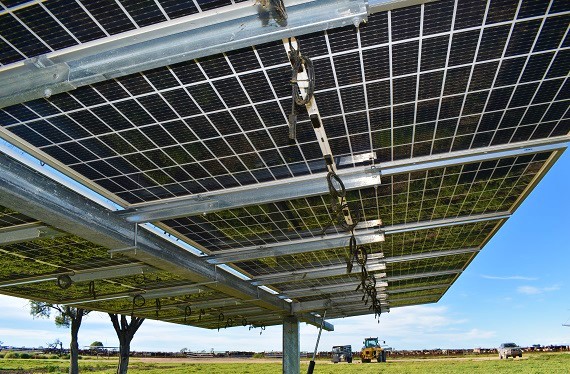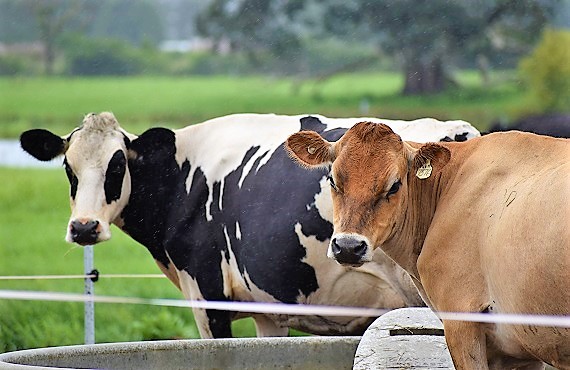Electricity supply constraints and opportunities for intensive industries
Intensive agricultural industries are typically high electricity users but are sometimes located in regions where the local electricity grid is currently experiencing constraints or is expected to become constrained in the future as increased electrification and agricultural production leads to higher electricity demand. Grid constraints expose farmers to increased risk of blackouts and brownouts, which can seriously impact their ability to operate and generate an income. Electricity supply interruptions may also result in negative consequences for worker safety and animal health, for example, unmilked cows developing mastitis.
NSW DPIRD funded two projects that investigated energy supply issues and possible solutions for intensive agricultural industries. The Agricultural Renewable Energy Acceleration (AREA) project was a research collaboration between NSW DPIRD and the NSW Farmers Association, focussed on Norco dairy farmers in north-east NSW, providing a framework for cost effective, whole of system approaches to sustainable regional electricity and acceleration of adoption of small to mid-scale renewable generation. The Energy Infrastructure for Future Farming project mapped the energy intensity of intensive agricultural industries and the capacity of the Essential Energy electricity network in regional NSW and identified opportunities to deploy renewables on-farm as an alternative to sourcing electricity from the grid. The projects found that improving energy efficiency and generating renewable energy on-farm not only increases energy security on farms but can also reduce energy costs and emissions.
NSW Farmers Agricultural Renewable Energy Acceleration (AREA) project
The AREA project was led by NSW Farmers and funded by NSW DPIRD. Other participants in the project were Norco dairy co-operative, University of Technology Sydney Institute of Sustainable Futures, University of NSW, Essential Energy and pitt&sherry engineering and environmental consultancy.
The project was undertaken in several phases. The initial phase involved spatial mapping of about 100 Norco dairy farms and the local electricity distribution network in northeast NSW. From the analysis undertaken in the first phase, 10 farms were selected for metering and energy audits. Data from the metering and audits was utilised to model and create case studies of on-site energy optimisation opportunities. The project demonstrated that opportunities exist to optimise energy use within the agricultural sector via approaches that include energy efficiency, local renewable energy generation, demand control and flexible demand. A systematic approach to their introduction can generate multiple benefits, including reduced energy bills, reduced network infrastructure investment, and reduced emissions for regional NSW.
Six focus areas to improve energy efficiency on dairy farms were identified in the project:
- Milk pre-cooling
- Vacuum pump upgrades
- Refrigeration upgrades
- Heat recovery and hot water adjustments
- Metering and monitoring to improve visibility of energy efficiency and flexibility opportunities.
- Shifting water pumping from peak periods.
Demand flexibility was identified as critical to allow farmers to better match loads with on-site renewable generation and also provide support to the electricity grid by reducing peak demand. By leveraging “flexible demand”, such as batteries, pumps, hot water systems and refrigeration, farmers can utilise more renewable energy generated on farm. Leveraging flexible demand means using electricity at “better” times, such as in the middle of the day when there is excess energy being generated by solar photovoltaic (PV) systems. This flexibility can also support the electricity grid by reducing peak demand or addressing minimum system load where solar PV systems need to be switched off if there is too much electricity being generated. By providing these services, flexible renewable energy systems can reduce the cost of energy for all customers in the region.
Outputs from the AREA project, including an energy productivity guide for dairy farms, case studies of dairy energy efficiency options and an analysis of optimal solar and battery solutions can be found on the NSW Farmers website.
NSW Farmers published a four-page article about the AREA project, including a case study, in the July-August 2022 edition of The Farmer magazine. A second case study from the project was featured in December 2022.
Energy Infrastructure for Future Farming project
In recent years, there have been trends of increasing volumes of agricultural output being produced using more intensive production methods and rising levels of electrification as industries seek to improve efficiency and lower emissions. In response, the Energy Infrastructure for Future Farming project was conducted to identify agricultural regions at risk of energy supply disruptions in the near term (to 2030) by developing spatial layers to map the location of energy intensive agricultural industries in NSW and the network capacity of the Essential Energy electricity distribution network. In addition, the project sought to gauge the feasibility of transitioning to on-farm clean energy solutions to improve energy security and also reduce energy costs and emissions.
The project was conducted by consultants CutlerMerz and a report setting out the project scope, approach, summary of mapping outputs and costs and factors to consider in relation to deploying on-farm clean energy solutions can be found here.
The spatial layers can be viewed in the map below.
The Essential Energy distribution network is shown, colour-coded for remaining capacity. Red feeder lines have the least remaining capacity while yellow feeder lines have the most remaining capacity. To locate a specific town, enter the town name in the search box provided. To view the location and energy intensity of intensive agricultural activities, select the “Ag_LandUse_Intensity” box on the key. The deeper the purple, the more energy intensive the agricultural activity taking place. Click on purple shaded areas to view a pop-up box containing land use i.e. type of agricultural activity, and energy intensity data.
Note, the layers may take time to load due to the high volume of data. The land use intensity layer can only be viewed when map is zoomed in.
